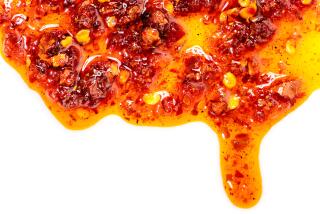Trademark owners with super-successful products stand bravely against a dreaded tide: lower case
- Share via
Having been reproached several times over the years for misusing trademarks, I am more than ordinarily sensitive to them.
I am not likely, for example, to write that I xeroxed a document, since Xerox is a trademark, requires a capital letter and may not be used as a verb.
But I know and you know that almost everyone today uses xerox as a verb.
Very probably the Xerox corporation lawyers will be on me for this, but I use xerox as a generic only to make their point.
Any newspaper columnist who has not been rebuked by Xerox has probably been rebuked by Coca-Cola for transgressing on its trademark Coke. The word Coke, they are quick to point out, is unique. It means Coca-Cola, and it does not mean any other type of cola drink. Some years ago the Coca-Cola company got onto bars for serving rum and some other cola drink when a patron asked for rum and Coke.
They’re that touchy.
I think the problem became acute during World War II when thousands of young sailors, mostly from the farmlands of the Middle West and Texas, volunteered into the Navy and took to drinking Schenley and Coke, as a way of proving their manhood. Schenley was not great whisky, but these lads had grown up on Coke, and they were branching out into hard liquor a step at a time. Mix it with Coke, it couldn’t be too bad. Also, a Schenley pint bottle at that time had a convex bend, so that it could be strapped to a sailor’s leg and smuggled aboard his ship.
What got Coca-Cola angry was that when sailors ordered Schenley’s and Coke, the bartenders would usually give them some cheaper cola. To say the least, it was unpatriotic.
I once received a letter from the president of the Spackle company complaining about my use of spackle as a generic. I had written something about spackling a crack in the wall.
Now everyone knows that when you fill a crack in a plaster wall with some plastic goop you spackle it. Yet, technically, that is trespass, because Spackle is a trade name and is protected by trademark law.
Unfortunately for Spackle, however, the name has already been rendered generic by the process trade-name owners call “genericide.”
Webster’s Third International lists spackle as a lower-case noun and verb that is derived from the trademark Spackle. I don’t know whether that would be a defense in court for its use as a generic, but there it is.
I have also been called down by Dow Chemical for using Styrofoam as an adjective for the kind of boxes food is served in. Actually, I used it that way in a quotation, as follows:
“We ordered,” she said, “and shortly he served our dinners--in Styrofoam boxes--but with as much presence as if the fare was cracked crab and Champagne. . . .”
I promptly received a letter from the communications manager of Styrofoam Brand Products, a division of Dow Chemical, advising me that “while Dow applies the Styrofoam brand name in marketing several products, including a number and variety of plastic foams, the items you mention are not Dow products to which this trademark applies.”
The problem, as you can see, is that these companies are confounded by their own success.
With the proliferation of products in this consumer world, their makers have an ever harder time thinking up names that will be unique, descriptive and catchy. More and more, as Jube Shiver Jr. recently pointed out in the Times business section, corporations with new products leave selection of their names to professional name consultants.
Simply sitting around the office and brainstorming a name doesn’t work anymore. There are so many registered names out there that finding an unused one can’t be left to chance.
Xerox, like Kodak, was an inspiration. If Chester Carlson had named his invention the Carlson Copier, instead of Xerox, the company wouldn’t have had any problem with trademark erosion.
Oddly, trademark owners don’t want their trademarks to be used as synonyms for the product. They want it used as an adjective, as in Kleenex tissue, Crayola crayon, Dacron polyester, Scrabble crossword game and Scotch brand transparent tape.
I think that asks too much of us.
The language tends to simplify itself. Why say “Scotch brand transparent tape” when everyone know what “Scotch tape” means? Why say “Kleenex tissue” when everyone knows what a Kleenex is? And who, in an emergency, is going to ask for a “Band-Aid adhesive bandage”?
From 1980 to 1985, Shiver noted, the number of trademarks registered with the U.S. Patent and Trademark Office more than quadrupled, from 16,366 to 71,167.
The newer trademarks, probably thought up by counseling firms, are cuter than ever. They especially run to puns:
A makeup brush is called Sweeping Beauty; a cleanser is called Tyrone Scour; foundation garments are called Line Tamer, Anchors-a-Waist, Sweet-Add-a-Line, Anything But the Truth and Waist-a-way.
In his new book, “A Collector’s Compendium of Rare and Unusual, Bold and Beautiful, Odd and Whimsical Names” (Delacorte), Paul Dickson lists some trade names that have been lost to common usage through genericide: aspirin, kerosene, kiddiecar, monopoly, mineral oil, parcheesi, pilsner beer, celluloid, trampoline, cube steak, wind breaker, raisin bran, yo-yo, mimeograph (soon to be followed by Xerox), milk of magnesia, lanolin, thermos, nylon, formica, calico, dry ice, shredded wheat, zipper, hansom, cellophane and escalator. It’s good to know that if you want to call somebody a yo-yo you’re not violating a trademark.
More to Read
Inside the business of entertainment
The Wide Shot brings you news, analysis and insights on everything from streaming wars to production — and what it all means for the future.
You may occasionally receive promotional content from the Los Angeles Times.










